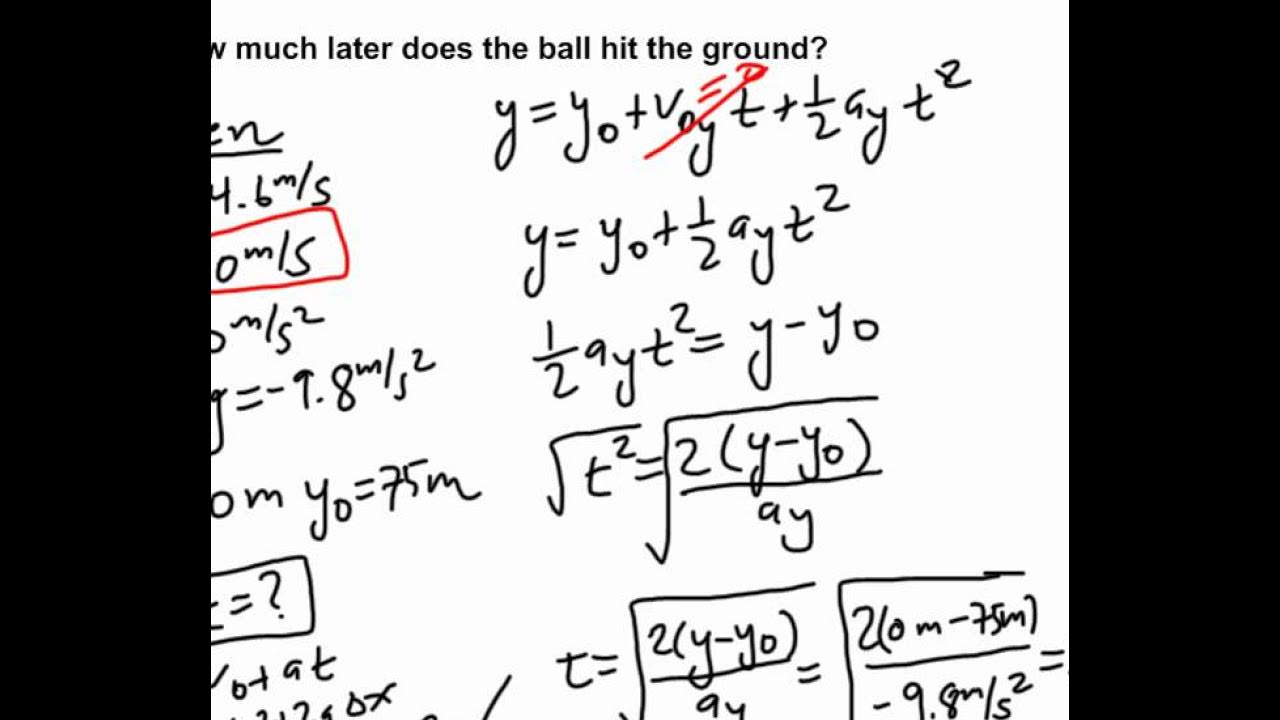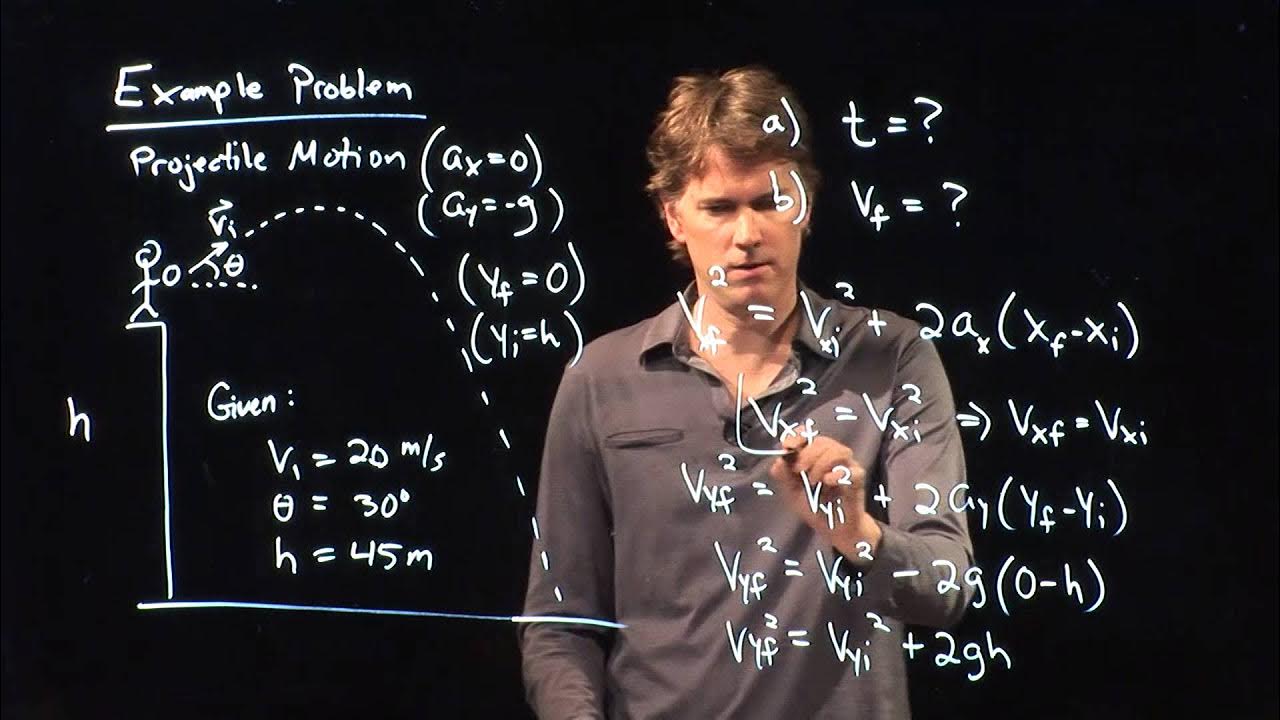Two Dimensional Motion Problems - Physics
TLDRIn this educational video, the presenter tackles a two-dimensional motion problem involving a ball rolling off a cliff. The video is segmented into parts, each addressing a different aspect of the problem: determining the time it takes for the ball to hit the ground, calculating the horizontal distance it travels (range), finding the final speed just before impact, and finally, determining the final velocity with its direction. The presenter uses fundamental physics equations and concepts, such as kinematics and projectile motion, to guide the viewer through the calculations, ultimately providing the answers: 10.1 seconds to hit the ground, a range of 50.5 meters, a final speed of 99.1 m/s, and a final velocity at an angle of 272.9 degrees counterclockwise from the positive x-axis.
Takeaways
- 📌 A ball rolls horizontally off a 500-meter cliff at a speed of 5 meters per second.
- 🔢 The problem is solved in multiple parts: time to hit the ground, range from the cliff base, final speed, and final velocity just before impact.
- 🕒 To find the time to hit the ground, use the formula y_final = y_initial + v_y_initial * t + 0.5 * a * t^2 with y_initial = 500m, v_y_initial = 0 m/s, and a = -9.8 m/s^2 (due to gravity).
- 🎯 The ball takes 10.1 seconds to hit the ground from the cliff.
- 🏁 The range (horizontal distance) from the base of the cliff is calculated by multiplying the horizontal velocity (5 m/s) by the time in the air (10.1 s), resulting in 50.5 meters.
- 🚀 The final speed of the ball just before impact is determined by using the Pythagorean theorem with the horizontal velocity (5 m/s) and the newly calculated vertical velocity (-98.98 m/s), resulting in a speed of 99.1 m/s.
- 📐 The final velocity includes both speed and direction; the ball's velocity vector is found to be 99.1 m/s at an angle of 272.9 degrees counterclockwise from the positive x-axis.
- 🌐 The problem-solving approach involves defining positions of interest (initial and final) and applying kinematic equations to calculate various aspects of the motion.
- 🔍 For additional context and formulas, the script suggests referring to videos on kinematics, projectile motion, and free fall physics.
- 🧠 The problem demonstrates the application of physics concepts such as free fall, projectile motion, and the use of kinematic equations to solve two-dimensional motion problems.
Q & A
What is the initial condition of the ball's horizontal velocity?
-The initial horizontal velocity of the ball is 5 meters per second.
What is the height of the cliff from which the ball rolls off?
-The height of the cliff is 500 meters.
How can we determine the time it takes for the ball to hit the ground?
-We use the kinematic equation for vertical motion: y_final = y_initial + v_y_initial * t + 0.5 * a * t^2, where y_initial is the height of the cliff, v_y_initial is the initial vertical velocity (which is zero), a is the acceleration due to gravity (-9.8 m/s^2), and t is the time in seconds. Solving for t gives us the time it takes for the ball to hit the ground.
What is the formula to calculate the range of the projectile?
-The range (horizontal distance) of the projectile is calculated using the formula: range = horizontal velocity * time. In this case, the horizontal velocity is 5 m/s and the time is 10.1 seconds, as determined from the previous calculation.
How do we find the final vertical velocity of the ball just before it hits the ground?
-The final vertical velocity is found using the formula: v_final = v_initial + a * t, where v_initial is the initial vertical velocity (zero in this case), a is the acceleration due to gravity (-9.8 m/s^2), and t is the time in flight (10.1 seconds).
What is the final speed of the ball just before it hits the ground?
-The final speed of the ball is calculated using the Pythagorean theorem, combining the constant horizontal velocity (5 m/s) and the calculated final vertical velocity (-98.98 m/s). The final speed is 99.1 m/s.
How do we determine the final velocity of the ball just before it hits the ground?
-The final velocity is determined by considering both the magnitude (speed) and the direction of the velocity vector. The speed is 99.1 m/s, and the direction is found by calculating the angle using arctan(v_y / v_x). The angle is then adjusted to be measured counterclockwise from the positive x-axis to find the final velocity vector.
What is the significance of the angle in the final velocity vector?
-The angle in the final velocity vector indicates the direction of the ball's velocity relative to the positive x-axis. In this case, the angle is 272.9 degrees counterclockwise from the positive x-axis, which tells us that the ball is moving in the fourth quadrant of the coordinate system.
How does the horizontal velocity of the ball change during its flight?
-The horizontal velocity of the ball does not change during its flight because there is no acceleration in the horizontal direction. It remains constant at 5 meters per second throughout the motion.
What is the acceleration acting on the ball during its entire motion?
-The only acceleration acting on the ball during its entire motion is the acceleration due to gravity, which is -9.8 m/s^2 acting in the vertical direction.
What is the total distance the ball travels horizontally before it hits the ground?
-The total horizontal distance the ball travels before it hits the ground is the range of the projectile, which is calculated as 5 meters per second (horizontal velocity) times 10.1 seconds (time in flight), resulting in 50.5 meters.
What is the combined effect of the horizontal and vertical velocities on the ball's motion?
-The combined effect of the horizontal and vertical velocities results in the ball's trajectory following a parabolic path. The horizontal velocity contributes to the range, while the vertical velocity, influenced by gravity, determines the peak height and the time of flight, ultimately affecting the final speed and direction of the ball just before impact.
Outlines
📐 Initial Two-Dimensional Motion Problem
The video begins by introducing a two-dimensional motion problem involving a ball rolling horizontally off a cliff. The problem is set up with the ball at position A (initial position) and position B (final position). The cliff's height is given as 500 meters, and the ball's horizontal speed is 5 meters per second. The goal is to calculate the time it takes for the ball to travel from position A to B and hit the ground. The video suggests referring to other videos for a list of kinematics equations needed to solve such problems. The equation used here is specifically for vertical motion, which allows the calculation of time (t) using the given values and the formula y_final = y_initial + v_y_initial*t + 0.5*a*t^2. By rearranging the formula and solving for t, the time is found to be 10.1 seconds.
🏌️♂️ Projectile Range Calculation
The second part of the video focuses on calculating the range of the projectile, which is the horizontal distance the ball travels before hitting the ground. The range is determined by multiplying the constant horizontal velocity (VX) by the time of flight (t) previously calculated. With VX at 5 meters per second and t at 10.1 seconds, the range is calculated to be 50.5 meters. The video also explains the concept of a projectile and how gravity is the only force acting on it. It emphasizes that the horizontal velocity remains constant while the vertical velocity changes due to acceleration caused by gravity.
🚀 Final Speed of the Ball
In this section, the video script discusses how to find the final speed of the ball just before it hits the ground. It explains that the ball's velocity now has both an X and Y component. The X component remains constant at 5 meters per second, while the Y component is calculated using the formula V_final = V_initial + a*t, which results in a final vertical velocity of -98.98 meters per second. To find the final speed, the Pythagorean theorem is applied, combining the X and Y components to yield a final speed of 99.1 meters per second. The video provides a clear understanding of how to calculate the speed when dealing with motion in two dimensions.
🎯 Final Velocity Vector
The final part of the video addresses the calculation of the final velocity vector of the ball, which includes both magnitude (speed) and direction. The angle (Theta) is determined using the arctan function, taking the ratio of the vertical velocity component (VY) to the horizontal velocity component (VX). The reference angle is found to be 87.1 degrees, and by considering the direction of the velocity vector (counterclockwise from the positive X-axis), the final angle is calculated to be 272.9 degrees. The video concludes by summarizing that the final speed is 99.1 meters per second, and the final velocity is this speed at an angle of 272.9 degrees from the positive X-axis, providing a comprehensive understanding of the motion of the projectile in both magnitude and direction.
Mindmap
Keywords
💡Two-dimensional motion
💡Projectile
💡Free fall
💡Acceleration
💡Kinematics
💡Velocity
💡Projectile range
💡Final speed
💡Velocity vector
💡Position of interest
💡Physics equations
Highlights
The problem begins with a ball rolling horizontally off a 500-meter cliff at a speed of 5 meters per second.
The initial position (A) is at the cliff's edge, and the final position (B) is when the ball hits the ground.
The height of the cliff is given as 500 meters, and the ball's horizontal speed is 5 meters per second.
The time it takes for the ball to hit the ground is calculated using the formula for vertical motion.
The final position (B) is at ground level, hence the final y-value is zero.
The initial vertical velocity (v_y initial) is zero because the ball only has a horizontal component at the start.
The vertical acceleration for an object in free fall is -9.8 m/s^2 due to gravity.
The equation used to solve for the time (t) is y_final = y_initial + v_y_initial * t + 0.5 * a * t^2.
The ball takes 10.1 seconds to fall from the cliff to the ground.
The range (horizontal distance) of the projectile is calculated by multiplying the horizontal velocity by the time of flight.
The ball lands 50.5 meters away from the base of the cliff.
The final speed of the ball just before it hits the ground is determined by using the Pythagorean theorem.
The final speed is 99.1 meters per second.
The final velocity of the ball includes both speed and direction, calculated by considering both the horizontal and vertical components of velocity.
The angle of the velocity vector is found using the arctan function and is measured counterclockwise from the positive x-axis.
The final velocity of the ball is 99.1 m/s at an angle of 272.9 degrees.
The video provides a comprehensive guide on solving two-dimensional motion problems using physics equations.
Additional resources like videos on projectile motion, kinematics, and free fall physics are recommended for further understanding.
Transcripts
Browse More Related Video

Projectile launched off a cliff at an angle

AP Physics B Kinematics Presentation General Problems #10

Projectile Launched of a Cliff

AP Physics B Kinematics Presentation #35

Rectilinear Motion Problems - Distance, Displacement, Velocity, Speed & Acceleration

Projectile Motion Example - How fast when it hits the ground
5.0 / 5 (0 votes)
Thanks for rating: